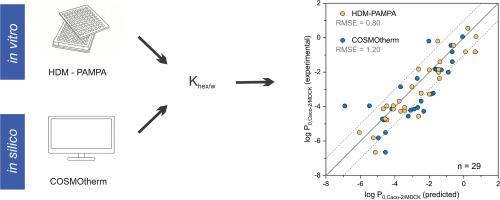从hdm - pampa衍生的十六烷/水分配系数预测Caco-2/MDCK固有膜透性。
IF 4.7
3区 医学
Q1 PHARMACOLOGY & PHARMACY
引用次数: 0
摘要
可靠的膜透性数据在早期药物开发中是必不可少的。因此,迫切需要可靠的实验高通量筛选方法,或者理想情况下,准确的预测工具,以评估膜的渗透性。在之前的研究中,我们证明了在精确的十六烷/水分配系数(Khex/w)可用的情况下,溶解度-扩散模型可以成功预测生物Caco-2和MDCK膜的被动渗透率。本研究采用HDM-PAMPA法测定Khex/w。我们用这种方法测量了我们自己的数据(64种化合物),并将结果与黑脂膜(BLM)实验和经典两相系统等既定方法进行了比较。我们的结果显示了不同方法之间的良好一致性,我们的数据和文献值都非常接近。利用这些实验确定的Khex/w值,我们基于先前校准的方程实现了Caco-2和MDCK细胞膜渗透率的准确预测(RMSE = 0.8,n = 29)。我们使用UFZ-LSER数据库和COSMOtherm软件进一步评估了Khex/w的计算机预测。COSMOtherm的实验测量结果几乎一样好(RMSE = 1.20,n = 29),而LSER方法(RMSE = 1.63,n = 29)在实验描述符可用或作为COSMOtherm的补充时最适用。这项工作突出了Khex/w在高通量渗透率估计中的实际应用,可以支持药物研究中候选药物的有效筛选和优先排序。本文章由计算机程序翻译,如有差异,请以英文原文为准。

Predicting Caco-2/MDCK intrinsic membrane permeability from HDM-PAMPA-derived hexadecane/water partition coefficients
Reliable membrane permeability data are essential in early drug development. Therefore, there is a strong need for robust experimental high-throughput screening methods, or ideally, accurate predictive tools, to assess membrane permeability. In a previous study, we demonstrated that the solubility-diffusion model can successfully predict passive permeability across biological Caco-2 and MDCK membranes, provided accurate hexadecane/water partition coefficients (Khex/w) are available.
In this study, we investigated the HDM-PAMPA method for determining Khex/w. We measured our own data (64 compounds) using this assay and compared the results with established methods such as black lipid membrane (BLM) experiments and classical two-phase systems. Our results show good agreement across methods, with both our data and literature values aligning closely.
Using these experimentally determined Khex/w values, we achieved accurate predictions of permeability in Caco-2 and MDCK cell membranes (RMSE = 0.8, n = 29) based on a previously calibrated equation. We further evaluated the in silico prediction of Khex/w using the UFZ-LSER database and the software COSMOtherm. COSMOtherm performed nearly as well as experimental measurements (RMSE = 1.20, n = 29), while the LSER approach (RMSE = 1.63, n = 29) is best applied when experimental descriptors are available or as a complement to COSMOtherm. This work highlights the practical utility of Khex/w in high-throughput permeability estimation, which can support efficient screening and prioritization of drug candidates in pharmaceutical research.
求助全文
通过发布文献求助,成功后即可免费获取论文全文。
去求助
来源期刊
CiteScore
9.60
自引率
2.20%
发文量
248
审稿时长
50 days
期刊介绍:
The journal publishes research articles, review articles and scientific commentaries on all aspects of the pharmaceutical sciences with emphasis on conceptual novelty and scientific quality. The Editors welcome articles in this multidisciplinary field, with a focus on topics relevant for drug discovery and development.
More specifically, the Journal publishes reports on medicinal chemistry, pharmacology, drug absorption and metabolism, pharmacokinetics and pharmacodynamics, pharmaceutical and biomedical analysis, drug delivery (including gene delivery), drug targeting, pharmaceutical technology, pharmaceutical biotechnology and clinical drug evaluation. The journal will typically not give priority to manuscripts focusing primarily on organic synthesis, natural products, adaptation of analytical approaches, or discussions pertaining to drug policy making.
Scientific commentaries and review articles are generally by invitation only or by consent of the Editors. Proceedings of scientific meetings may be published as special issues or supplements to the Journal.

 求助内容:
求助内容: 应助结果提醒方式:
应助结果提醒方式:


